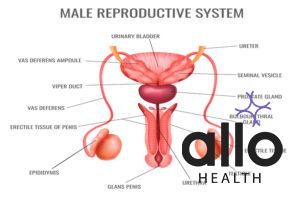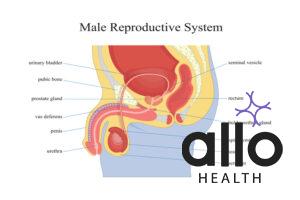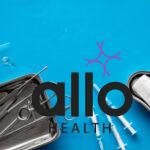Male Reproductive System

Allo Health is dedicated to personalized well-being, offering support and trusted information tailored to individual health goals. The platform emphasizes human-generated content, led by a distinguished medical team of experts, including physicians and sexual health specialists. Their commitment to credibility involves rigorous fact-checking, authoritative research, and continuous updates to ensure accurate, up-to-date information. Allo Health's unique approach goes beyond conventional platforms, providing expert-led insights and a continuous commitment to excellence, with user feedback playing a crucial role in shaping the platform's authoritative voice.

A Psychotherapist with Clinical specialization, working for over seven years now. Areas of specialization range from Anxiety-related disorders, Mood-related disorders, Personality disorders, Sexual dysfunctions & other mental health issues.
Why This Was Upated?
Our experts continually monitor the health and wellness space, and we update our articles when new information became available.
Updated on 03 November, 2023
- Article was updated as part of our commitment to diversity, equity, and inclusion.

"The following blog article provides general information and insights on various topics. However, it is important to note that the information presented is not intended as professional advice in any specific field or area. The content of this blog is for general educational and informational purposes only.
Book consultation
The content should not be interpreted as endorsement, recommendation, or guarantee of any product, service, or information mentioned. Readers are solely responsible for the decisions and actions they take based on the information provided in this blog. It is essential to exercise individual judgment, critical thinking, and personal responsibility when applying or implementing any information or suggestions discussed in the blog."
The male reproductive system is a group of organs and tissues that are responsible for producing and transporting sperm, as well as depositing them in the female reproductive tract. The male reproductive system is a complex system with the primary function to produce, store, and transport sperm from the male to fertilize an egg in the female. Proper function of the male reproductive system is important for fertility and the ability to have children. Any problems with the male reproductive system, such as infertility or impotence, can be treated by a doctor.
What Organs Are Part Of The Male Reproductive System?

The male reproductive system consists of several external and internal organs that work together to produce, store and transport sperm, as well as to deliver semen during ejaculation
External Organs
The external organs of the male reproductive system include the penis, scrotum, and testicles.
Penis
The penis is the primary male reproductive organ and is responsible for delivering semen from the male into the female reproductive tract during sexual intercourse. It contains many sensitive nerve endings. The penis is composed of several structures including the shaft, the glans penis, and the root. The shaft is the main body of the penis, while the glans is the rounded head at the top and the root is the base of the penis that connects it to the pelvic bones.
Scrotum
The scrotum is a sac of skin that surrounds and protects the testicles. The scrotum helps to regulate the temperature of the testicles, which is crucial for sperm production. This sac also contains the cremaster muscle, which helps to move the testicles closer to or further from the body to maintain the optimal temperature for sperm production.
Testicles
The testicles are the male gonads and are responsible for producing and storing sperm. The testicles are also responsible for producing the hormone testosterone, which is crucial for the development of male sexual characteristics and sperm production. The testicles are located inside the scrotum and are surrounded by a layer of supportive tissue called the tunica albuginea.
Internal Organs
In addition to these external organs, the male reproductive system also includes several internal organs, such as the seminal vesicles, the prostate gland, the vas deferens, and the ejaculatory ducts. These organs work together to produce, store, and transport semen.
The male reproductive system is a complex network of internal organs that work together to produce and transport sperm. The primary organs of the male reproductive system include the testes, epididymis, vas deferens, seminal vesicles, prostate gland, and the urethra.
Testes
The testes are the primary reproductive organs in males, responsible for producing sperm and secreting the male sex hormone testosterone. The testes are located in a pouch of skin called the scrotum and are highly sensitive to temperature changes. This is why they are located outside of the body, as the optimal temperature for sperm production is slightly lower than body temperature.
Leydig Cells
Leydig cells, also known as interstitial cells, are the primary source of testosterone in the male reproductive system. They are located within the testes and play a critical role in maintaining male sexual health and reproductive function.
Anatomy of Leydig Cells
Leydig cells are found in the interstitial tissue of the testes, between the seminiferous tubules where sperm are produced. They are oval-shaped cells that are approximately 20-30 micrometers in diameter. The cytoplasm of Leydig cells is rich in smooth endoplasmic reticulum and mitochondria, which are necessary for the production of testosterone.
Function of Leydig Cells
Leydig cells produce testosterone, which is the primary male hormone responsible for male sexual development and maintenance of sexual function. Testosterone is essential for the growth and maintenance of the male reproductive system, including the testes, prostate, and penis. It also plays a critical role in the development of secondary sexual characteristics, such as increased muscle mass, body hair, and a deep voice. In addition, testosterone regulates the production of sperm and is essential for male fertility.
Importance of Leydig Cells
Leydig cells play a crucial role in maintaining male sexual health and reproductive function. Without sufficient testosterone production, males can experience a variety of health issues, including decreased sexual desire, erectile dysfunction, decreased muscle mass and bone density, and infertility. Moreover, the decline in testosterone production as men age can lead to a condition known as andropause, which can result in a decline in physical and mental well-being.
Sertoli Cells
Sertoli cells are specialized cells in the male reproductive system that play a crucial role in male fertility. These cells are located in the testes and are involved in several important functions that are necessary for sperm production and maturation. The study of Sertoli cells is a rapidly growing field of research, with new discoveries being made regularly that help to shed light on the complex processes that occur within the male reproductive system.
Functions of Sertoli cells
- Support the germ cells (the cells that produce sperm) as they mature and develop. This includes providing the germ cells with nutrients and hormones, as well as secreting various substances that help to regulate the growth and development of the germ cells. Sertoli cells are also involved in the formation of the blood-testis barrier, which helps to protect the developing sperm from harmful substances and prevent their premature release.
- In addition to supporting sperm development, Sertoli cells also play a role in regulating the activity of the hypothalamic-pituitary-gonadal (HPG) axis. This is the complex physiological system that is responsible for regulating the production of hormones and other substances involved in reproduction. By releasing various signaling molecules, Sertoli cells are able to communicate with other cells in the male reproductive system, helping to regulate the release of hormones and other substances.
One of the most exciting areas of research into Sertoli cells is the role they may play in the development of male infertility. In recent years, scientists have been studying the effects of various environmental and lifestyle factors, such as exposure to toxins, stress, and a poor diet, on the function of Sertoli cells. This research has shown that these factors can have a significant impact on the health and function of Sertoli cells, which in turn can lead to infertility.
There is also a growing body of research that suggests that Sertoli cells may play a role in the development of testicular cancer. This type of cancer is becoming increasingly common, with rates of diagnosis rising in recent years. Scientists are investigating the role that Sertoli cells may play in the development of testicular cancer, as well as the potential for Sertoli cells to be used as a target for cancer therapies.
Epididymis, Vas deferens and Seminal Vesicles
The epididymis is a coiled tube that lies atop each testicle, where it stores and matures sperm. During sexual arousal, the muscle contractions lead the sperm to the vas deferens. The sperm then travels through the vas deferens, a long, muscular tube that carries sperm from the epididymis to the urethra. The seminal vesicles, present behind the urinary bladder, two small glands located near the base of the bladder, produce a fluid that helps to nourish and protect the sperm during ejaculation.
Prostate Gland and Urethra
The prostate gland is a small, chestnut-shaped gland that sits just below the bladder and surrounds the urethra. It secretes a fluid that makes up a large portion of semen, the fluid that carries sperm during ejaculation. The urethra is a long, muscular tube that carries semen and urine out of the body.
In addition to these primary organs, there are several accessory glands and structures that play a role in the male reproductive system.
Bulbourethral Glands and Cowper’s Glands
These include the bulbourethral glands, which are pea-sized structures that produce a clear, lubricating fluid that neutralizes any acid in the urethra before ejaculation of semen, and the Cowper’s glands, which produce a pre-ejaculatory fluid that helps to clean the urethra.
Functions Of The Male Reproductive System

The male reproductive system plays a crucial role in the process of human reproduction. It is responsible for producing, storing, and delivering sperm to fertilize a female’s egg. The main functions of the male reproductive system include the production of sperm, the release of testosterone, and the transportation of sperm from the testes to the external environment.
Sperm Production
The testes, also known as testicles, are the primary site for sperm production. The testes produce millions of sperm every day and are responsible for the continuation of the human species. The process of sperm production is called spermatogenesis and occurs in the seminiferous tubules of the testes. The sperm undergo several stages of development before they are released into the epididymis, where they mature and become capable of fertilizing an egg.
Testosterone Release
Testosterone is the primary male sex hormone and plays a crucial role in the development of male reproductive tissues and secondary sex characteristics, such as muscle mass and body hair. The testes produce most of the testosterone in a man’s body. Testosterone also helps regulate the production of sperm and affects sexual desire.
Sperm Transportation
The transportation of sperm from the testes to the external environment is a complex process that involves several structures. The epididymis is a coiled structure located at the back of the testes and is responsible for the storage and bringing the sperm to maturity. The vas deferens, also known as the ductus deferens, is a muscular tube that transports sperm from the epididymis to the ejaculatory duct. The ejaculatory duct, in turn, joins the urethra, which is the duct that carries both urine and semen to the outside of the body during ejaculation.
Hormone Production Of The Male Reproductive System
Hormones play a crucial role in regulating various functions of the male reproductive system, including sperm production, sexual development, and behavior.
Testosterone
Testosterone is the primary and most well-known hormone in the male reproductive system. It is produced by the testes and is responsible for the development of male secondary sexual characteristics such as facial hair, a deep voice, and increased muscle mass. Testosterone also plays a crucial role in sperm production and maintenance of libido. Low testosterone levels can lead to infertility, decreased sex drive and osteoporosis.
Luteinizing hormone (LH)
LH is produced by the pituitary gland and stimulates the production of testosterone in the testes. It also triggers the process of sperm production, known as spermatogenesis. Elevated levels of LH can indicate a problem with the testes, such as testicular failure or damage.
Follicle-stimulating hormone (FSH)
FSH is also produced by the pituitary gland and is essential for sperm production. It stimulates the growth and maturation of the cells in the testes responsible for producing sperm. FSH levels are often measured along with LH levels to diagnose problems with the male reproductive system.
Dehydroepiandrosterone (DHEA)
DHEA is a hormone produced by the adrenal glands and is converted into testosterone in the body. It is important for sperm production and sexual development. Low levels of DHEA can lead to infertility and decreased libido.
Prolactin
Prolactin is a hormone produced by the pituitary gland and is best known for its role in milk production in women. However, it also plays a role in the male reproductive system, as elevated levels can lead to decreased testosterone production and infertility.
Key Takeaways:
- The male reproductive system is responsible for producing, storing, and transporting sperm for fertilization and reproduction.
- It includes external organs such as the penis, scrotum, and testicles, and internal organs like the epididymis, vas deferens, seminal vesicles, prostate gland, and urethra.
- Sperm production occurs in the testes, while testosterone is produced primarily in the testes and plays a crucial role in male sexual characteristics and sperm production.
- Hormones like testosterone, luteinizing hormone (LH), and follicle-stimulating hormone (FSH) regulate various functions of the male reproductive system.
- Problems with the male reproductive system, such as infertility or impotence, can be treated with medical intervention.
- Regular medical checkups and communication with a healthcare professional are essential for maintaining male reproductive health.
Frequently Asked Questions
Q: What is the male reproductive system?
A: The male reproductive system is a complex network of organs and tissues responsible for producing, storing, and transporting sperm, as well as producing the male sex hormone testosterone.
Q: What is the role of testosterone in the male reproductive system?
A: Testosterone is the primary male sex hormone produced in the testes. It is crucial for the development of male sexual characteristics, sperm production, and regulating libido.
Q: What are the components of semen?
A: Semen is composed of sperm and various fluids from the male reproductive system, including secretions from the seminal vesicles, prostate gland, and bulbourethral glands. It contains nutrients and substances that support and nourish sperm, aiding in their survival and motility.







































